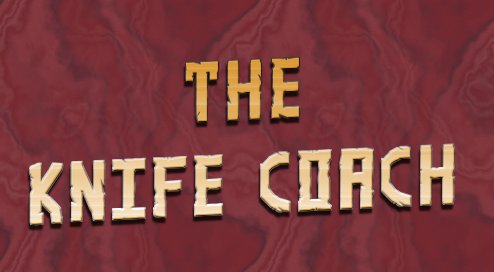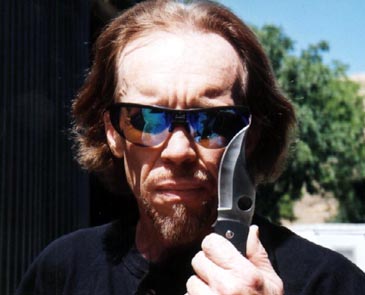
Knife Coach Keeps it simple for YOU: Session #4
Four Elements and Five Critical Moves
In the world we are currently living in it is very easy to get into trouble if you are a knife carrying individual. A simple traffic stop or snoopy colleague at work, not worrisome things unto themselves. But if either one see's you wearing a knife they could become a source of trouble for you. Some states are worse than others as we all know. Yes friends, thing have gotten pretty bad. And if Australia, the U.K. and other places are any sign, we here in the USA are also headed down the same dismal road. Prepare now friends, I implore you to begin "adjusting" now. The sooner the better!
I am a fan of the old motto "Keep it simple". I believe in that principle personally. I recommend it to you also - you see I am not a mere knife fighter. I am a tactician, a strategist who just happens to prefer the knife over other forms of protection. Keeping it simple on a man to man fighting level instantly brings to mind the "Cinco Teros". Simple, fast, deadly and do-able! The Cinco Teros is a highly respected method which can be done with either sticks, fixed blade knives or folding knives (locks or no-locks).
I am also fan of the palming method for using smaller knives for defense. A small folder can be safely held, used and retained using the palm method. Those who know what a "Petjut" is (the whip hand) and how it is used will see a very close resemblance to the palming style of using a small folder. The strokes and body postures are quite close to one another. The palming style I refer to is what is taught in Mexico and that is where my friend Santos learned this method which he shared with me and others. (he even designed and built a knife for this very style). (PS: Santos and his son Benji were the winners of ten grand on AMC's new TV show called "SHOWVILLE". Benji danced really well and my friend Santos and his entire family were showcased nicely. Check it out if you can, it was the first show of the season.)
Working off of the basic (#5) thrust and the upwards and downwards diagonal lines of the universal segno the simplicity and the ferocity of the Cinco Teros method just bursts forth. It is an easy to maintain means of real defense. There are other styles and methods equaly as good. I merely used the Cinco Teros method as an example of what I speak. Complicated techniques are not as important as is having courage in your heart during moments of danger. Simple techniques combined with courage are often some of the most impressive when the chips are down.
Next let's talk about getting the tactical advantage over the other guy. You have your knife and whoa, look out! He has his knife too! Ok, so what comes next? Think quickly! In my world I'd recommend that you get a shield and instantly gain an immediate advantage. By the addition of a shield you can up your survival quotient by a full 80%! Yes, a shield makes that MUCH of a difference in close quarter knife fighting. A shield nearly guarantees your victory!
But who the hell has a shield lying about? Well, conceptually speaking they are damn near everywhere. I do not mean an actual viking style shield. I meant it's modern counterpart which would be a "field expedient" shield. For example you might use your briefcase as a shield. Another common idea of a shield is to roll your coat about your forearm. This effectively protects you from his blade. It is a proven method made famous by the Spanish and Mexican knife men who used a Serape over their forearms for protection from the enemies blade and to parry his deadly advances.
Keep your eye out for prospective protective shields of impromtu nature where ever you are. Every environment has some sort of something that would suffice in a pinch. In the gun fighting world it is a known tactic that if you are being fired upon you should first seek out protective cover before attempting to return fire. In the case of a knife fight you should seek out a protective covering - a similar self-survival mindset as that of the trained gunman.
The knife you carry should be nonscript. Probably a small gentleman's folder is a good example. Nothing tactical or too big. (keep it simple). Inexpensive and no type of blade lock - learn to operate with only the bare minimum. Your better off if you train with the bare minimum. If you then end up with something a bit more replete then by God you can consider yourself lucky that day.
For this "simple work" we are speaking about I myself prefer a three or four inch Texas Toothpick (folder). Their design is timeless. It fills the hand like a fighting piece. A Barlow design or that of a Trapper does not give the same feel as the Texas Toothpick, but they'll do. The three inch model toothpick is my favorite. There is a four inch model available and it is sweet too. But then the size can tip off a smart observer and cause you problems. The 3 inch Texas Toothpick is a classic bare minimum unit (no blade lock). It was a favorite of the Southern knife fighters during the great depression. It was what was available to buy during that era and what men liked in a true "pocket knife".
In the pocket the unit is hidden away. Using a clip knife you run the risk of having that knife seen by others. It can be construed as a "fast draw" knife. A pocket knife cannot be seen nor designated as fast draw (but it actually is quite fast) - shhh, don't tell! Heh heh! Just use a tiny piece of cardboard in the blade groove of your folder until the very point is extened above the frame. Then use that exposed tip to catch on the lip of your pants pocket. As the knife comes out of your pocket it is also opening it for business. Fast! It can be hard on the britches though if you do it too much.
Well, now to the purpose of these short knife applications. Seek not to kill, seek instead to wound and disable, then escape (get the hell away). The idea is to keep your life and body intact. Do just what is needed and no more. Fighting to someone's demise can have many hidden pitfalls. There are levels of trouble and being too bloodthirsty is a very bad level to be at. It is near madness this bloodlust and the masters knew it centuries ago! Controlled it must be or it will surely control YOU my friend. Blood has this odd quality about it, this why some form of discipline is always a part of any racket which involves blood as a a part of it's path.
A larger blade, say 3'' and upwards to machetes. That weapon is the power, it is the threat and respect getter. In untrained or trained hands a knife like that is dangerous in all ways. But begin going below that size, say 3" inches and below and the task of really hurting or even killing another becomes much, much harder to pull off. The knife itself has little threat to it, it cannot wound too grievously, so the enemy lacks fear-respect. So...where then does this small method come in then? The small knife method depends on YOU. Normally the other larger knives you depend on THEM.
If you know some form of panatuken, wing chun or advanced hand boxing methods then this is the fertile ground to grow your small knife ability. Your "boxing" skill transfers over, point work over edge work. The small knives offer such short or limited cutting surface, but point is never bad. Point goes past heavy winter clothing where edge would have failed. So when people ask me why bother with that Kung Fu BS? I respond by saying it turbo-charges my knife work, esp. my small knife stuff.
Even though I know a bunch of cool, badass effective knife stuff most of it would be worthless with a knife that has a two inch blade. It's just going to piss off a determined adversary and make them crazier. So time to kick in the advanced hand skills and use them to augment the small knife and over ride it's weak points and BOOM! You have a very slick - effective way to employ the smallest of knives (or tactical pens, pencil, a lit cigar, etc). Points are everywhere for the knife fighter. Edges, not so much. We use point because of this fact.
Respect for life is also a factor here. Unlike a bullet a knife can be called back and made tame. Once the bullet leaves the barrel it cannot be stopped or called back. A knife can be stopped and called back even at the last moment if you so decide. The 3 inch version of the Toothpick I mentioned earlier is big enough to get the job done. But it is more difficult to kill with it outright. It can be done of course, but we are not a way of death. We are a way of life. Give life, avoid taking life. Defend yourself at all times, but also where you can safely do it, show compassion and mercy as well. It will someday come back to you in a karmic fashion. Trust me on this and take the high road whenever you can in life. Be the professional and you'll never regret it!
In Review: The Four Elements:
1. Five critical moves done well
2. Addition of a Shield
3. A simple Texas Toothpick or any small folder
4. Wound & Escape vs Killing
Humble thanks from the Knife Coach for reading & watching !
I'll see you next session of the Maajak World "Summer Series" of self development articles and films !

TM



Welcome to Session number Four! Keeping it simple with the small knives !
 | ||||||